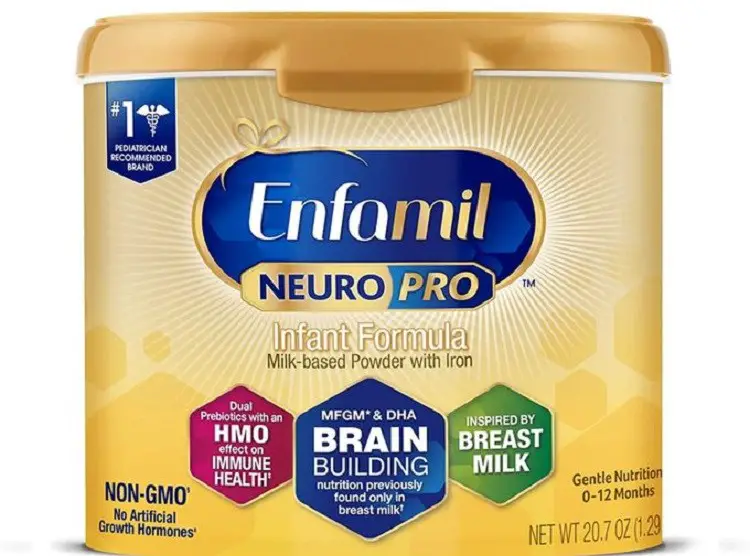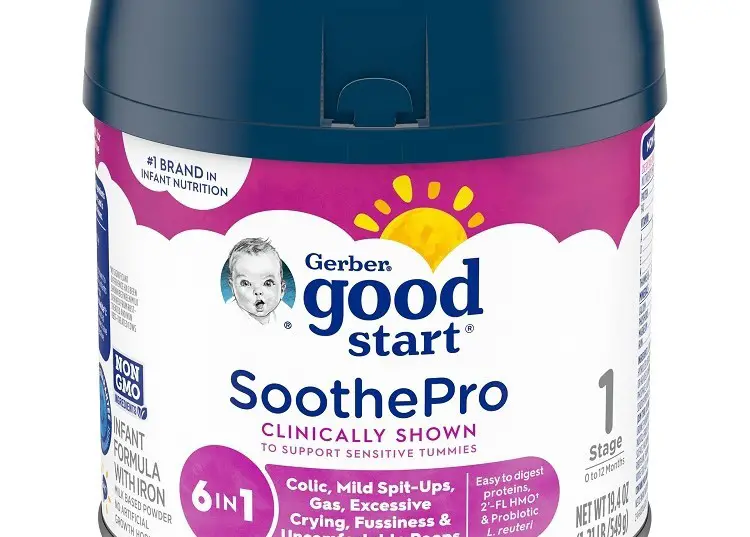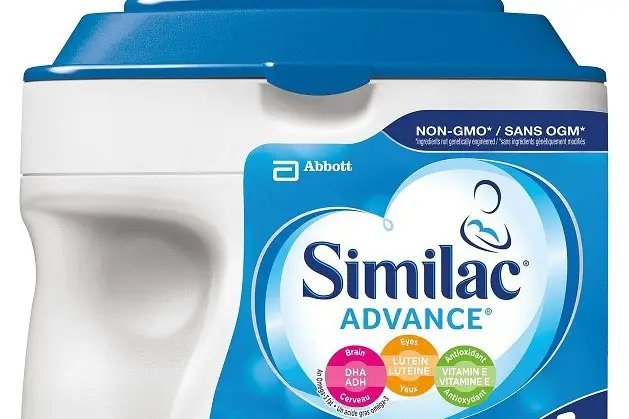Making a choice of formula for your little one can be overwhelming because of the varieties of formulas available in the local market.
Have you ever looked up Enfamil vs Similac vs Gerber, wondering which one of these formulas would be the best for your little one?
The truth is that the three brands of formula you are contemplating choosing from for your baby are all beautiful and can serve as great alternatives to breast milk.
In this article, we will present a lot of information about these three brands to you that will help you make your choice from these brands.
Table of Contents
- Enfamil vs Similac vs Gerber
- Enfamil vs Similac vs Gerber – Similarities & Differences
- Enfamil vs Similac vs Gerber at a Glance
- FAQs About Enfamil vs Similac vs Gerber
- Conclusion
Enfamil vs Similac vs Gerber
Enfamil Baby Formula

Enfamil is regarded as the leading baby formula brand that is readily available in the newborn nurseries of hospitals. However, it is a little bit more expensive than other formula brands.
This baby formula is specially manufactured to cater to your baby’s nutritional needs, especially as they journey through life, especially during their first year on the surface of planet earth.
There are different versions for different infant and toddler ages in the Enfamil brand, and they include:
- Newborn stage: 0-3 months
- Infant stage: 0-12 months
- Toddler stage: 2 and 3: Enfagrow 9 months-3 years.
Features
- It contains choline
- It contains Omega-3-DHA
- It includes a blend of two prebiotics
- It contains MFGM (Milk fat globule membrane) and Lactoferrin
- They offer a lactose-free version in Enfamil Nutramigen
- Enfamil offers its soy-based formula like the Enfamil Prosobee
Pros
- Rich in vitamins
- Excellent source of minerals
- Laden with nutrients that promotes growth
- Supports brain development
- Nourishes the body
Cons
- The product is expensive
- Has GMO versions
- Packaging quality issues when delivered by mail.
Read: How To Thicken Baby Formula Without Cereals
Gerber

Gerber has been christened the baby’s best friend, and the name is because the baby’s formula of this brand is manufactured with the required nutrients.
The brand also has options for baby formula that deal with fussiness, digestive issues, and CMPA, and not only that, their formulas are affordable and cost-effective.
Gerber’s formulas are non-GMO, and most parents would be more at home with non-GMO brands of formula.
Gerber formulas are laden with the essential nutrients required for growth.
Gerber has created a product line that caters to the needs of different infants and toddlers ages, and they include the following:
- Stage 1: Birth to 12 months
- Stage 2: 6-12 months
- Stage 3:12-24 months
Features
- It contains a blend of DHA, prebiotics, and probiotics.
- It contains essential ingredients that aid the development of a baby.
- It contains prebiotics.
- It contains probiotics
- It contains whey protein that eases fussiness and gassiness.
- They offer a lactose-free version in Gerber Good Start Extensive HA
- Gerber offers their soy-based formula like in Gerber Good Start Soy Powder
Pros
- It contains easy-to-digest proteins that are tummy-friendly
- It contains 2’-FL HMO
- It contains colic-reducing probiotic L.reuteri
- It is fortified with iron to prevent anemia
- Contains non GMO formula
Cons
- Preparation is sometimes tricky because it tends to clump
- It sometimes has a fishy odor
- Packaging quality issues when delivered by mail.
Read Also: Gerber vs Cerelac – Features, Pros & Cons
Similac

Similac produces a variety of baby formulas to meet the needs of different types of babies and infants.
Their products have proven to be formulated with changing nutritional needs to support your growing child’s overall physical and mental development.
Features
- It contains 2’-FL HMO
- It contains DHA
- It contains Lutein
- It contains Vitamin E
Pros
- Improved Eye Q plus nutrition
- Laden with natural vitamin E
- Contains Lutein
- It contains DHA that supports brain and eye development.
Read: Best Baby Formula Thickeners
Enfamil vs Similac vs Gerber – Similarities & Differences
Similarities
There are some similarities between Enfamil, Gerber, and Similac, including the following.
- They have varieties of baby formula milk products.
- These brands have a non-GMO version of their sensitive formulas
- According to FDA, it is safe for consumption by babies
- Both include comfort proteins like DHA and ARA that helps improve brain and eye development
Differences
- In terms of price, Enfamil is costlier than the rest
- Enfamil is made from more natural ingredients than others
- Enfamil utilizes fewer sugars than others
- The content of choline, pantothenic acid, folic acid, and inositol is higher in Enfamil than in the rest.
- Similac is a better source of copper.
- Similac tends to improve in thiamin, vitamin D, riboflavin, niacin, and biotin.
- Gerber contains a blend of DHA, prebiotics, and probiotics.
Related Articles:
- Promil vs Similac – Which is Better?
- Enfamil NeuroPro Vs Gentlease
- Enfamil Nutramigen Vs Enfamil Sensitive
- Enfamil Sensitive vs. Similac Sensitive
- Enfamil Vs Similac Vs Nan Pro
Enfamil vs Similac vs Gerber at a Glance
In terms of formula for babies, there is no doubt that these brands are the leading brands in the market, and their similarities and discrepancies have been highlighted above.
If you want a product with less sugar for your baby, then Enfamil products become ideal because they contain fewer sugars.
If you prefer lutein products and lack palm olein oil, which is often associated with infantile constipation, then you should go for Similac products.
If you want a product with a blend of DHA, prebiotics, and probiotics, then you should go for Gerber products.
In terms of price, Enfamil products are usually more expensive than Similac and Gerber products of the same formulation.
If you are confused about the type of formula to go for, especially for a first-time mum, you must seek the advice of your pediatricians to go for the ideal formula for your baby.
FAQs About Enfamil vs Similac vs Gerber
Why Should I Use Baby Formula?
Baby formula is an excellent alternative for first-time parents that can’t breastfeed or decide not to. They include all the essential nutrients required for a baby’s growth.
How Much Formula Does My Baby Need?
Babies 4-6 months old who haven’t started eating solids can follow a simple guideline. Give 2.5 ounces of formula per pound of body weight each day, up to a maximum of 32 ounces.
For instance, if your little one weighs 6 pounds, offer them 15 ounces of formula in 24 hours. All babies are different; some will take more or less than the guideline above.
How To Know If My Formula-Fed Baby Is Hungry?
You will learn the signs that your baby is ready to feed after a few weeks. During this stage, your baby may become restless, turn their heads and open their mouths, which is called rooting.
Typically, they will find something to suck on, such as a fist or finger.
What Formula Taste Closest To Breastmilk?
Enfamil Enspire is the only formula in the US that contains both MFGM and Lactoferrin, making it as close to breastmilk as possible.
MFGM supports brain development, and Lactoferrin supports and aids the immune system.
Why Should I Discard Formula After An Hour?
Bacteria can grow when leftover formula and your baby’s saliva combine. Discard any leftover formula in your baby’s bottle.
When Should You Give Baby Cow Milk?
Experts recommend that parents wait until babies clock 9-12 months before introducing cow’s milk. Until this age, it is not a suitable replacement for formula or breast milk.
Conclusion
I am sure the breakdown of the similarities and discrepancies of the top infant formula brands will help you answer your question on Enfamil vs Similac vs Gerber.
Most parents will root for Enfamil products while others may root for Similac products and some Gerber products, but remember that what suits your baby and what you want for your baby matters most.
Babies have different choices, so it is advised that you give your baby what they want and, if you are confused, seek your pediatrician’s advice.
